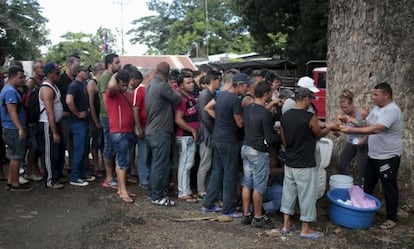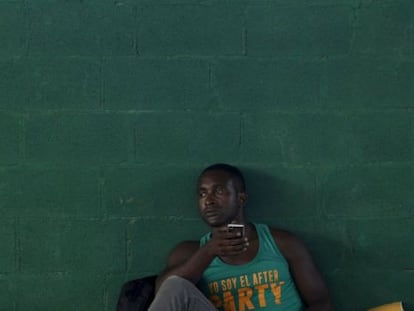Costa Rica struggling to deal with Cuban migrant crisis
Nicaragua keeping hundreds from crossing border and continuing their journey to US

In no way does Nasandy Soto want to return to Cuba. That is why she is waiting in line in the 38ºC heat with other Cuban migrants at the Peñas Blancas border crossing between Costa Rica and Nicaragua. The 34-year-old nurse is hoping she will eventually be able to cross the frontier and continue her journey to the United States.
The Nicaraguan government of President Daniel Ortega has blocked more than 1,000 Cubans who arrived in Costa Rica about a week ago from entering its territory and is accusing its southern neighbor of trying “to dump” the migrants on it.
This is the biggest refugee crisis Costa Rica has faced since the civil wars in Central America in the 1980s
The Costa Rican government gave the Cubans seven-day transit visas so that they can move freely across the country.
But because Managua has rejected them, the situation has grown into the biggest refugee crisis Costa Rica has faced since the civil wars that took place in neighboring countries during the 1980s.
It has been 18 days since Nasandy and her husband Eduardo Valdez fled their impoverished life in Cuba after selling their home and car.
She tells her story as she waits among the other migrants at the Peñas Blancas crossing where nuns, NGO workers and volunteers distribute meals. “We did what we could to leave Cuba,” she explains. “The journey is very difficult, dangerous and expensive. But the worst part was when I was put in a van by the Costa Rican immigration police. It wasn’t because I was scared about being arrested; I was scared that they would return us to Cuba.”
While Costa Rican Foreign Minister Manuel González has been holding long talks over the phone with his Nicaraguan counterpart, Bruno Rodríguez, the Cuban Embassy in San Jose has not gotten involved.
At the same time, a second group of migrants is waiting for a diplomatic solution to be hammered out around 20 kilometers away at a shelter set up by the Costa Rican government. They risk being shut out if Nicaragua agrees to temporarily open the border and let the Cubans being held back by the Nicaraguan police and military there to cross.
In Managua, officials see the matter as another “violation of sovereignty” by Costa Rica. Both countries are in the middle of a legal battle before the European Court of Justice in The Hague over a border dispute in the eastern part of their territories.
The Cubans reportedly arrived in Ecuador by plane and made their journey to Costa Rica by land, crossing Colombia and Panama. Their final goal is to reach Mexico and cross the border into the United States.
The Cuban government of Raúl Castro, which is aligned with Ortega, has not issued an opinion about Nicaragua’s mobilization of police and troops to the border to prevent the migrants from entering.
Costa Rica believes 13,000 may have made the journey since 2013 when Ecuador lifted entry visas for Cubans
However, the official Communist Party newspaper, Granma, blamed the United States for the problem.
“The Ministry of Foreign Affairs would like to emphasize that these citizens are victims of the politicization of the migration issue by the United States government,” Granma published on Tuesday.
Next month Costa Rican President Luis Guillermo Solís is due to become the first leader of his country to visit Cuba since Fidel Castro came to power in 1959. Costa Rica and Cuba established diplomatic relations in 2009.
After breaking up a human trafficking network that is said to be responsible for helping the immigrants, Costa Rica tried to apply strict controls at its southern Paso Canoas border crossing near Panama.
Costa Rican officials believe between 1,000 and 2,000 Cuban migrants may have entered the country and make up part of the 13,000 who have made the journey to the United States by land since 2013 when the leftist Ecuadorian government of Rafael Correa lifted all entry visa requirements for Cubans.
Panama has not complied with its job to contain them” Costa Rica immigration office chief Kathya Rodríguez
Since Tuesday, after the crisis began, 13 Cubans have applied for refugee status with the San Jose government, according to Carlos Maldonado, a representative of the UN High Commissioner for Refugees.
But Costa Rican officials fear that they have a greater problem because more Cubans are on their way. Around 136 more migrants entered the country on Tuesday.
“We have nearly 2,000 Cubans in this situation, in which they continue to enter from Panama,” Foreign Minister González said this week. “We cannot just seal the border.”
The crossing at Paso Canoas is an open gateway that can be passed by walking through a clothing store, a small restaurant, or through a yard located at a gasoline station.
“We have no other choice but to give them a transit visa, says Kathya Rodríguez, head of the Costa Rican immigration office. “Panama has not complied with its job to contain them.”
English version by Martin Delfín.
Tu suscripción se está usando en otro dispositivo
¿Quieres añadir otro usuario a tu suscripción?
Si continúas leyendo en este dispositivo, no se podrá leer en el otro.
FlechaTu suscripción se está usando en otro dispositivo y solo puedes acceder a EL PAÍS desde un dispositivo a la vez.
Si quieres compartir tu cuenta, cambia tu suscripción a la modalidad Premium, así podrás añadir otro usuario. Cada uno accederá con su propia cuenta de email, lo que os permitirá personalizar vuestra experiencia en EL PAÍS.
¿Tienes una suscripción de empresa? Accede aquí para contratar más cuentas.
En el caso de no saber quién está usando tu cuenta, te recomendamos cambiar tu contraseña aquí.
Si decides continuar compartiendo tu cuenta, este mensaje se mostrará en tu dispositivo y en el de la otra persona que está usando tu cuenta de forma indefinida, afectando a tu experiencia de lectura. Puedes consultar aquí los términos y condiciones de la suscripción digital.
More information
Últimas noticias
The complicated life of Francesca Albanese: A rising figure in Italy but barred from every bank by Trump’s sanctions
Reinhard Genzel, Nobel laureate in physics: ‘One-minute videos will never give you the truth’
Pinochet’s victims grapple with José Antonio Kast’s rise in Chile
How Japan is trying to avert ‘digital defeat’
Most viewed
- Pablo Escobar’s hippos: A serious environmental problem, 40 years on
- Reinhard Genzel, Nobel laureate in physics: ‘One-minute videos will never give you the truth’
- Why we lost the habit of sleeping in two segments and how that changed our sense of time
- Charles Dubouloz, mountaineering star, retires at 36 with a farewell tour inspired by Walter Bonatti
- The Florida Keys tourist paradise is besieged by immigration agents: ‘We’ve never seen anything like this’









































